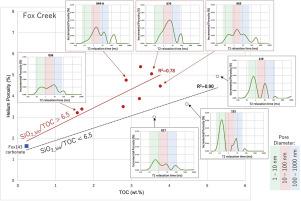当前位置:
X-MOL 学术
›
Int. J. Coal Geol.
›
论文详情
Our official English website, www.x-mol.net, welcomes your feedback! (Note: you will need to create a separate account there.)
The influence of rigid matrix minerals on organic porosity and pore size in shale reservoirs: Upper Devonian Duvernay Formation, Alberta, Canada
International Journal of Coal Geology ( IF 5.6 ) Pub Date : 2020-07-01 , DOI: 10.1016/j.coal.2020.103525 Levi J. Knapp , Omid H. Ardakani , Shinnosuke Uchida , Takashi Nanjo , Chiaki Otomo , Tatsuya Hattori
International Journal of Coal Geology ( IF 5.6 ) Pub Date : 2020-07-01 , DOI: 10.1016/j.coal.2020.103525 Levi J. Knapp , Omid H. Ardakani , Shinnosuke Uchida , Takashi Nanjo , Chiaki Otomo , Tatsuya Hattori

|
Abstract Organic porosity is an important component of the pore system in many shale hydrocarbon reservoirs. While much research has been directed towards understanding the development of organic porosity as a function of thermal maturity, relationships between mineralogy and organic porosity have been less extensively investigated. This study illustrates the role of rigid matrix minerals, particularly biogenically-sourced microcrystalline quartz, on organic porosity and pore size evolution. The Upper Devonian Duvernay Formation of western Canada is a siliceous-calcareous self-sourced reservoir with 3.2-3.79 wt. % average total organic carbon (TOC) content in a study area occurring in the volatile oil to dry gas thermal maturity zones. Biogenic silica is widely distributed throughout the matrix as microcrystalline quartz and locally comprises >50 wt. % of the rock. Porosity and pore size data gathered from BIB- and FIB-SEM, helium porosimetry, H1 NMR T2, and MICP indicate that organic porosity and pore size is enhanced when in association with biogenic silica. Biogenic silica forms a rigid siliceous matrix framework that limits compaction of pores and ductile organic matter and clay minerals. Where biogenic silica concentration is low, clay mineral (mica+illite) interparticle micro- and fine mesopores dominate. In these samples detrital quartz and biogenic silica have limited influence on pore size other than to preserve the small fraction of organic macropores. The occurrence of biogenic- and clay-dominated pore systems varies systematically with stratigraphic and lateral variations in lithofacies, and sharp contrasts are observed across sequence boundaries. The observation that mineralogy strongly influences organic pore preservation confirms that studies examining the relationship between thermal maturity and organic porosity must account for mineralogical variations.
中文翻译:

刚性基质矿物对页岩储层有机孔隙度和孔径的影响:加拿大阿尔伯塔省上泥盆统 Duvernay 组
摘要 有机孔隙度是许多页岩油气藏孔隙系统的重要组成部分。虽然许多研究都致力于了解有机孔隙度随热成熟度的变化,但矿物学和有机孔隙度之间的关系尚未得到广泛研究。这项研究说明了刚性基质矿物,特别是生物来源的微晶石英,对有机孔隙率和孔径演变的作用。加拿大西部上泥盆统 Duvernay 组是一个硅质-钙质自源储层,含 3.2-3.79 wt. % 平均总有机碳 (TOC) 含量在研究区发生在挥发油至干气热成熟区。生物二氧化硅作为微晶石英广泛分布在整个基质中,局部包含 > 50 重量。% 的岩石。从 BIB- 和 FIB-SEM、氦气孔隙率测定法、H1 NMR T2 和 MICP 收集的孔隙率和孔径数据表明,当与生物二氧化硅结合时,有机孔隙率和孔径得到增强。生物二氧化硅形成刚性硅质基质框架,限制孔隙和韧性有机物和粘土矿物的压实。在生物二氧化硅浓度低的地方,粘土矿物(云母+伊利石)颗粒间微孔和细孔占主导地位。在这些样品中,碎屑石英和生物二氧化硅对孔径的影响有限,除了保留小部分的有机大孔。以生物和粘土为主的孔隙系统的出现随着岩相的地层和横向变化而系统地变化,并且在层序边界上观察到了鲜明的对比。
更新日期:2020-07-01
中文翻译:

刚性基质矿物对页岩储层有机孔隙度和孔径的影响:加拿大阿尔伯塔省上泥盆统 Duvernay 组
摘要 有机孔隙度是许多页岩油气藏孔隙系统的重要组成部分。虽然许多研究都致力于了解有机孔隙度随热成熟度的变化,但矿物学和有机孔隙度之间的关系尚未得到广泛研究。这项研究说明了刚性基质矿物,特别是生物来源的微晶石英,对有机孔隙率和孔径演变的作用。加拿大西部上泥盆统 Duvernay 组是一个硅质-钙质自源储层,含 3.2-3.79 wt. % 平均总有机碳 (TOC) 含量在研究区发生在挥发油至干气热成熟区。生物二氧化硅作为微晶石英广泛分布在整个基质中,局部包含 > 50 重量。% 的岩石。从 BIB- 和 FIB-SEM、氦气孔隙率测定法、H1 NMR T2 和 MICP 收集的孔隙率和孔径数据表明,当与生物二氧化硅结合时,有机孔隙率和孔径得到增强。生物二氧化硅形成刚性硅质基质框架,限制孔隙和韧性有机物和粘土矿物的压实。在生物二氧化硅浓度低的地方,粘土矿物(云母+伊利石)颗粒间微孔和细孔占主导地位。在这些样品中,碎屑石英和生物二氧化硅对孔径的影响有限,除了保留小部分的有机大孔。以生物和粘土为主的孔隙系统的出现随着岩相的地层和横向变化而系统地变化,并且在层序边界上观察到了鲜明的对比。


























 京公网安备 11010802027423号
京公网安备 11010802027423号